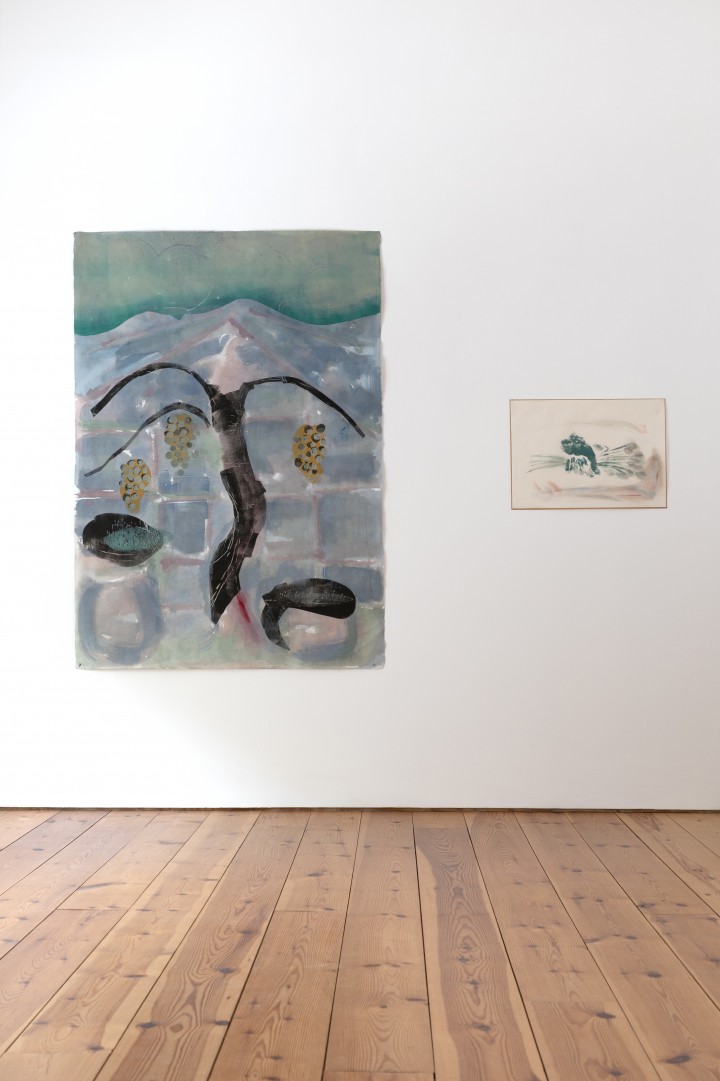Scottish Art News
Latest news
Magazine
News & Press
Publications
Lotte Gertz, Layers of Silt
By Greg Thomas, 19.08.2025

Lotte Gertz’s new exhibition at Cample Line includes 13 of the Glasgow-based artist’s new works on paper. Gertz’s previous practice has sometimes involved printing and painting onto fabric. Indeed, it’s interesting how fibrous and textile-like the various papers used in this exhibition appear (mulberry, awagami, hahnemühle). It’s something to do with their saturation with gouache wash, giving the surfaces a gently rippling, undulating topography. It’s also to do with the squint edges of the hand-cut sheets, a wavey looseness foregoing the geometrical exactness you might associate with the material.
All of this feels relevant because Gertz’s paintings have a lived-in quality, a sense of having been returned to again and again like a favourite garment. In an essay accompanying the show, the writer and curator Martin Clark notes that:
Gertz’s work, her painting, weaves through her life,...She is always making – drawing, painting, printmaking – but also gathering, looking, keeping, thinking. Things are put away and taken out again, sometimes months or years later. Fragments are returned to, reassembled, revisited. Pictures are stacked like geological strata, like layers of silt settling gently one on another.
Gertz’s work might be compared to that of another Scotland-based painter, Andrew Cranston, in giving this impression of layered memories. But whereas for Cranston the effect has something to do with the accumulation of detail, for Gertz it is bound up with the diverse means of applying ink and paint to surfaces, by which her pieces seem to accrue distinct visual strata.
In works such as 'Seedheads' (2025) and 'Caregiving as resistance' (2025), for example, there is a curious sense that two or more visual iterations of the same subject or idea are floating in-front on top of other. In each case there is a pale, liquid-seeming background, with gesturally rendered plants and soft, green-and- terracotta horizons: something between a landscape recalled in sleep and a sub- aquatic forest. This part of the work is created with watery gouache, all dissolving edges and efflorescence. In front are the sharper edges of relief prints, representing plants, trees, or seeds, which seem, because of the difference in facture, texture, and outline from what is behind, to be the product of a distinct creative intervention and emotional space. The two phases of composition are overlaid, suggesting a diachronic rendering of a single symbolic environment.
In other pieces, such as 'Landscape Time' (2025), the only work in the show actually created on fabric (calico), there is the complementary sense of a mix-up between figure and ground (this is more pronounced in some of Gertz’s previous work). The shapes and lines that most draw the eye seem to be created by absence rather than presence, specifically by the scraping away of paint or ink from the printing surface.
.jpg) Lotte Gertz, detail from work 'Children, compost, seedlings', (2025)
Lotte Gertz, detail from work 'Children, compost, seedlings', (2025)
The artist’s carefully chosen figurative motifs might quicken a sense of the work’s dreamlike qualities. The recurrent appearance of a hand, for example, reaching across the frame from some untold space or depth, strings of fabric or fauna draped
over the forearm (as in the two versions of 'We have come to cover you with wool' [2025]), seems to have an arcane allegorical significance. An image of magical revelation, perhaps, it speaks of the kind of meaning aloof to the rational mind but lucid to the unconscious one.
, 2025.jpg) Lotte Gertz, 'We have come to cover you with wool', (2025)
Lotte Gertz, 'We have come to cover you with wool', (2025)
This brings us on to the thematic aspects of Gertz’s practice as evidenced in this show. Maternity and other dimensions of embodied female experience; their connection to natural and inhabited spaces; the landscape as body and the body as landscape: all have something to offer. And all seem evident in 'Children, compost, seedlings' (2025), with its background of soft, blue squares edged with pink. The artist has noted that this is a visual evocation of her mother’s greenhouse. In this context, the tree and seed-bags in-front, and what look like pendulous bunches of fruit hanging off the branches, allude to the generative power of the female body. The lactating breast and conical projectile of 'Milk Splash' (2025) do so more unambiguously.
.jpg) Lotte Gertz, 'Seahorses with pregnant male', (2025)
Lotte Gertz, 'Seahorses with pregnant male', (2025)
The final work in the show is a stone lithograph of a hand holding a bunch of flowers, 'Repair' (2025), an homage of sorts to a painting by Louise Bourgeois, 'Reparation', which Gertz responded to from a half-formed memory of the piece. If the forebears she points to are anything to go by, then the female body as strong, productive, and nurturing – as in Bourgeois’s monumental 'Maman' spider-sculptures – is one interpretive idea to settle on. Then again, there is the soft-ground etching 'Seahorses with pregnant male' (2025), in which gender roles are pointedly confused, and feminist earth-mother tropes are troubled. In any case, these readings are prompted rather than neatly illustrated by the works, which have a capacious, surrealistic ambiguity to them, and are well worth spending time with.
Lotte Gertz's exhibition Layers of Silt is exhibited at Cample Line until 31st August




